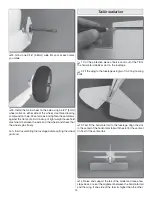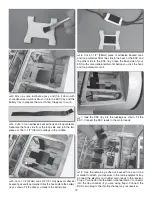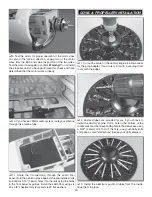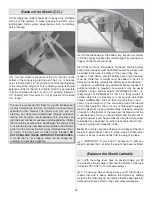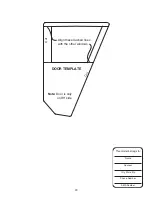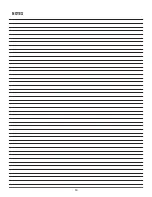
23
Pilot Installation (Optional)
To install a pilot figure, please use the Great Planes 1/5th
scale sport pilot. This is available in red, yellow, or blue. Please
see the parts list earlier in this manual for these part numbers.
❏
1. Cut the pilot figure down to 3" [76mm] using a razor
saw or your hobby knife. Sand the bottom of the figure flat
using a belt sander or a sanding block.
❏
2. Sand the inside surface of the pilot figure and clean it
with denatured alcohol. Cut and glue a wooden base (not
included) inside the pilot figure using 6-minute epoxy. Let the
epoxy cure.
❏
3. Glue the pilot figure in the cockpit.
❏
4. Install the canopy.
Apply the Decals
1. Be certain the model is clean and free from oily fingerprints
and dust. Prepare a dishpan or small bucket with a mixture
of liquid dish soap and warm water—about one teaspoon of
soap per gallon of water. Submerse the decal in the soap
and water and peel off the paper backing. Note: Even though
the decals have a “sticky-back” and are not the water transfer
type, submersing them in soap & water allows accurate
positioning and reduces air bubbles underneath.
2. Position decal on the model where desired. Use the
photos on the box for reference. Holding the decal down,
use a paper towel to wipe most of the water away.
3. Use a piece of soft balsa or something similar to squeegee
remaining water from under the decal. Apply the rest of the
decals the same way.
4. We have also included a template for the passenger door.
Turn to the back of this manual and cut this out. Hold it up to
the right hand side of the model and trace the outline of the
door onto the fuselage using a panel line pen.
GET THE MODEL READY TO FLY
Center the Controls and
Check the Control Directions
Warning: Once the battery is connected to the ESC, stay
clear of the propeller!
❏
1. Turn on the transmitter, center the trims, and move the
throttle stick all the way down. Plug your airplane’s battery
into the ESC.
❏
2. Check to see that the controls are centered. If any
control requires adjustment, remove the clevis and tighten
or loosen it to adjust the length of the pushrod. Tighten the
clevis to “shorten” the pushrod or loosen it to “lengthen” the
pushrod. Reinstall the clevis snapping closed the arms, and
fit the silicone retainer over the clevis arms to secure it. If you
have to remove a servo arm to make an adjustment, don’t
forget to reinstall the locking screw.






